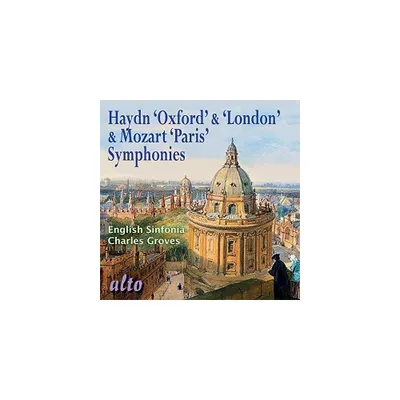Home
Haydn: London Symphony No. 103; Theresienmesse
Loading Inventory...
Barnes and Noble
Haydn: London Symphony No. 103; Theresienmesse
Current price: $22.99


Barnes and Noble
Haydn: London Symphony No. 103; Theresienmesse
Current price: $22.99
Loading Inventory...
Size: OS
*Product Information may vary - to confirm product availability, pricing, and additional information please contact Barnes and Noble
Boston's
Handel and Haydn Society
experienced a full transition to a historical-instrument ensemble under conductor
Harry Christophers
, and they couldn't have chosen a better person for the job.
Christophers
accomplished the changeover while not losing sight of the
Society
's big, public traditions, and the result is a hybrid that fully satisfied the
's tradition-minded listeners. Probably approaching the end of his tenure in Boston,
even seems to feel that he can stretch out a bit. On his release, featuring the
Symphony No. 103 in B flat major
, he gives timpanist
Jonathan Hess
the opportunity to play a little cadenza in the titular drum roll at the beginning of the work. This isn't the sort of thing that one expects from
, and listeners can sample it for themselves; to these ears, it works, as does the modified form of the cadenza when it returns, "Pathetique" sonata-style, at the end of the movement. The main attraction is
Haydn
's
Mass in B flat major, Hob. 22/12 ("Theresienmesse")
, which displays all of
' strengths. The
choir achieves a richness that does not foreclose the liveliness that is so essential to
, and his soloists, absolutely top-notch, seem to flow naturally from the larger structures of the music. There's a good deal of drama in both these works, in the mysterious slow introduction to the first movement of the symphony and at many places in the mass, and
seems unconstrained by his usual slightly decorous style. There are decisions here with which some will disagree, but it's a very strong release, and Boston's Symphony Hall sounds great. ~ James Manheim
Handel and Haydn Society
experienced a full transition to a historical-instrument ensemble under conductor
Harry Christophers
, and they couldn't have chosen a better person for the job.
Christophers
accomplished the changeover while not losing sight of the
Society
's big, public traditions, and the result is a hybrid that fully satisfied the
's tradition-minded listeners. Probably approaching the end of his tenure in Boston,
even seems to feel that he can stretch out a bit. On his release, featuring the
Symphony No. 103 in B flat major
, he gives timpanist
Jonathan Hess
the opportunity to play a little cadenza in the titular drum roll at the beginning of the work. This isn't the sort of thing that one expects from
, and listeners can sample it for themselves; to these ears, it works, as does the modified form of the cadenza when it returns, "Pathetique" sonata-style, at the end of the movement. The main attraction is
Haydn
's
Mass in B flat major, Hob. 22/12 ("Theresienmesse")
, which displays all of
' strengths. The
choir achieves a richness that does not foreclose the liveliness that is so essential to
, and his soloists, absolutely top-notch, seem to flow naturally from the larger structures of the music. There's a good deal of drama in both these works, in the mysterious slow introduction to the first movement of the symphony and at many places in the mass, and
seems unconstrained by his usual slightly decorous style. There are decisions here with which some will disagree, but it's a very strong release, and Boston's Symphony Hall sounds great. ~ James Manheim


















